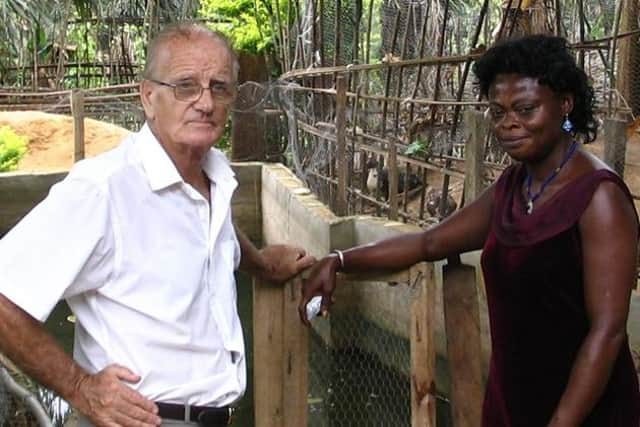Obituary: Lawrie Mitchell, globetrotting doctor who followed in footsteps of Mary Slessor


Lawrie Mitchell was a globetrotting doctor with a remarkably eclectic career who, had it not been for a sports injury, may not have become a medic at all. As a teenager he had planned to work in journalism but when he broke his collar bone playing rugby the ensuing spell in Dundee Royal Infirmary changed his mind. Laid up for several weeks, the talented young sportsman resolved to train as a doctor – no small feat since, smart though he was, he had no science subjects.
He was, however, single-minded and secured a place at St Andrews University, duly mastering the necessary sciences and completing his medical degree before embarking on an international career that saw him travel from Canada to the Middle East and Africa, working on projects as diverse as the care of 40,000 refugees in war-torn Chad to looking after stars on a film set. But his greatest legacy is the Mary Slessor Foundation in Nigeria, inspired by the Scots missionary who improved the lives of 19th century tribespeople, promoted women’s rights and rescued children from infanticide.
Advertisement
Hide AdAdvertisement
Hide AdBorn in Dundee, Mitchell was the son of Euphemia and Baxter, a truancy officer and scout for Dundee United. Educated at Morgan Academy, he maintained lifelong links with his old school, where he had been a fine rugby player and cricketer. By the time he graduated from university, in 1963, he was married with three children and supplemented his salary as a junior doctor by working as a labourer on a Dundee construction site.
The family soon emigrated to Canada where he worked in Newfoundland and he and wife Pat, a fellow St Andrews student, had their fourth child. He then set up and led the emergency department of a new hospital in Ottawa where they spent seven years.
But with a growing family and a yearning to give the children a Scottish education, they returned home in 1975 and settled in Monikie. A spell as a locum GP saw him work in a variety of locations including Blairgowrie, Hemel Hempstead, Arran and Lewis, until he got a call from the British Medical Association in London offering him a post at the Military Hospital, Tabuk in Saudi Arabia.
After a year in the Middle East he accepted a position that took him to Chad, heading a medical team for the refugee charity UNHCR in the midst of the country’s civil war. There he established a camp for 40,000 refugees – which rebels would infiltrate at night, ripping intravenous lines from patients – and provided services alongside Medecins sans Frontieres, working with the French Army, including a unit of the Foreign Legion. That assignment ended when they were bombed by Gaddafi.
His next foray was to Nigeria where a nine-month contract to set up medical support for a paper mill project led to him working there for almost a decade. Other jobs included a couple of spells as medic on the QE2, where he won the ship’s table tennis trophy, and a stint as doctor on the set of the 1980 TV movie the Curse of King Tut’s Tomb, an enterprise dogged by mishaps: Raymond Burr collapsed, Eva Marie Saint was almost electrocuted and Mitchell had to arrange for Ian McShane to be medevaced when he broke his leg.
In 1994 Pat, a teacher, died of breast cancer, just as she was about to complete her PhD. Widowed Mitchell, who was already familiar with Nigeria and Mary Slessor’s achievements, subsequently visited the missionary’s house in Akpap where he was shown around by a local woman, Eme, whose great great grandmother had helped Slessor become accepted by chieftains in Calabar a century earlier.
Eme and Mitchell married in Dundee and returned to live near Calabar for more than 20 years. There he worked for a company building an aluminium smelter plant before heading to Russia and Kazakhstan as medical director of Caspian Pipeline Consortium. Very much conscious of the deprivation in the surrounding rural area, the couple was determined to echo Mary Slessor’s commitment to local people and in 2000 Mitchell set up the Foundation in her name.
Based in Akpap Okoyong, north of Calabar, its work encompasses social, economic and healthcare projects, including a small hospital, vocational skills training centre and agricultural processing unit. Mitchell ran a clinic, organised village standpipes to eliminate the daily 5km trek for water, got midwives on motorbikes to reach areas where they were desperately needed and utilised his own Volvo estate as an ambulance, negotiating the dangerous, rough and ready roads – where it was not unknown for him to be held-up at gunpoint – to help the sick. At its peak the Foundation reached out to a community of 40,000, providing employment and medical care. All of this was achieved with quiet resolve and without fanfare. When he was made an MBE in 2008 for services to community development in Nigeria he saw it as an opportunity to highlight the charity and emphasise the country’s positive aspects. Never one to stand on ceremony, he had to be persuaded to attend the investiture and turned up at Buckingham Palace in a £6 suit bought in a charity shop the previous day.
Advertisement
Hide AdAdvertisement
Hide AdHe and Eme retired to Portugal in 2007 where he dispensed medical advice as required, read The Lancet, kept in touch with countless former patients and indulged his love of political discussion, usually over a sundowner. He is survived by Eme, children Gary, Neil, Sean and Shionaghand five grandchildren.
ALISON SHAW